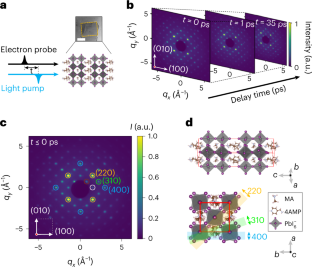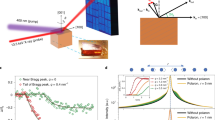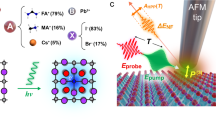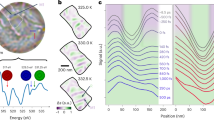Abstract
Direct visualization of ultrafast coupling between charge carriers and lattice degrees of freedom in photoexcited semiconductors has remained a long-standing challenge and is critical for understanding the light-induced physical behaviour of materials under extreme non-equilibrium conditions. Here we obtain a direct visualization of the structural dynamics in monocrystalline 2D perovskites. We achieve this by monitoring the evolution of wavevector-resolved ultrafast electron diffraction intensity following above-bandgap high-density photoexcitation. Our analysis reveals a light-induced ultrafast reduction in antiferro-distortion resulting from a strong interaction between the electron–hole plasma and perovskite lattice, which induces an in-plane octahedra rotation towards a more symmetric phase. Correlated ultrafast spectroscopy performed at the same carrier density as ultrafast electron diffraction reveals that the creation of a dense electron–hole plasma triggers the relaxation of lattice distortion at shorter timescales by modulating the crystal cohesive energy. Finally, we show that the interaction between carrier gas and lattice can be altered by tailoring the rigidity of the 2D perovskite by choosing an appropriate organic spacer layer.
This is a preview of subscription content, access via your institution
Access options
Access Nature and 54 other Nature Portfolio journals
Get Nature+, our best-value online-access subscription
$29.99 / 30 days
cancel any time
Subscribe to this journal
Receive 12 print issues and online access
$209.00 per year
only $17.42 per issue
Buy this article
- Purchase on Springer Link
- Instant access to full article PDF
Prices may be subject to local taxes which are calculated during checkout




Similar content being viewed by others
Data availability
All of the data supporting the findings of this study are available in the Article and Supplementary Information. Any additional data are available from the corresponding authors upon reasonable request. Source data are provided with this paper.
Code availability
The analysis code for this study is available from the corresponding authors upon reasonable request.
References
Tsai, H. et al. High-efficiency two-dimensional Ruddlesden–Popper perovskite solar cells. Nature 536, 312–316 (2016).
Li, L. et al. Tailored engineering of an unusual (C4H9NH3)2(CH3NH3)2Pb3Br10 two-dimensional multilayered perovskite ferroelectric for a high-performance photodetector. Angew. Chem. 129, 12318–12322 (2017).
Yuan, M. et al. Perovskite energy funnels for efficient light-emitting diodes. Nat. Nanotechnol. 11, 872–877 (2016).
Qin, C. et al. Stable room-temperature continuous-wave lasing in quasi-2D perovskite films. Nature 585, 53–57 (2020).
Gong, X. et al. Electron–phonon interaction in efficient perovskite blue emitters. Nat. Mater. 17, 550–556 (2018).
Blancon, J.-C., Even, J., Stoumpos, C. C., Kanatzidis, M. G. & Mohite, A. D. Semiconductor physics of organic–inorganic 2D halide perovskites. Nat. Nanotechnol. 15, 969–985 (2020).
Kepenekian, M. et al. Concept of lattice mismatch and emergence of surface states in two-dimensional hybrid perovskite quantum wells. Nano Lett. 18, 5603–5609 (2018).
Blancon, J.-C. et al. Extremely efficient internal exciton dissociation through edge states in layered 2D perovskites. Science 355, 1288–1292 (2017).
Smith, M. D., Jaffe, A., Dohner, E. R., Lindenberg, A. M. & Karunadasa, H. I. Structural origins of broadband emission from layered Pb–Br hybrid perovskites. Chem. Sci. 8, 4497–4504 (2017).
Tamarat, P. et al. The dark exciton ground state promotes photon-pair emission in individual perovskite nanocrystals. Nat. Commun. 11, 6001 (2020).
Neutzner, S. et al. Exciton-polaron spectral structures in two-dimensional hybrid lead-halide perovskites. Phys. Rev. Mater. 2, 064605 (2018).
Yin, J. et al. Tuning hot carrier cooling dynamics by dielectric confinement in two-dimensional hybrid perovskite crystals. ACS Nano 13, 12621–12629 (2019).
Quan, L. N. et al. Vibrational relaxation dynamics in layered perovskite quantum wells. Proc. Natl Acad. Sci. USA 118, e2104425118 (2021).
Guo, Z., Wu, X., Zhu, T., Zhu, X. & Huang, L. Electron–phonon scattering in atomically thin 2D perovskites. ACS Nano 10, 9992–9998 (2016).
Jia, X. et al. Observation of enhanced hot phonon bottleneck effect in 2D perovskites. Appl. Phys. Lett. 112, 143903 (2018).
Straus, D. B. et al. Direct observation of electron–phonon coupling and slow vibrational relaxation in organic–inorganic hybrid perovskites. J. Am. Chem. Soc. 138, 13798–13801 (2016).
Ni, L. et al. Real-time observation of exciton–phonon coupling dynamics in self-assembled hybrid perovskite quantum wells. ACS Nano 11, 10834–10843 (2017).
Guo, P. et al. Direct observation of bandgap oscillations induced by optical phonons in hybrid lead iodide perovskites. Adv. Funct. Mater. 30, 1907982 (2020).
Thouin, F. et al. Phonon coherences reveal the polaronic character of excitons in two-dimensional lead halide perovskites. Nat. Mater. 18, 349–356 (2019).
Schmitt-Rink, S., Chemla, D. S. & Miller, D. A. B. Theory of transient excitonic optical nonlinearities in semiconductor quantum-well structures. Phys. Rev. B 32, 6601–6609 (1985).
Chemla, D. S. & Miller, D. A. B. Room-temperature excitonic nonlinear-optical effects in semiconductor quantum-well structures. J. Opt. Soc. Am. B 2, 1155–1173 (1985).
Stampfli, P. & Bennemann, K. H. Time dependence of the laser-induced femtosecond lattice instability of Si and GaAs: role of longitudinal optical distortions. Phys. Rev. B 49, 7299–7305 (1994).
Harb, M. et al. Carrier relaxation and lattice heating dynamics in silicon revealed by femtosecond electron diffraction. J. Phys. Chem. B 110, 25308–25313 (2006).
Wu, X. et al. Light-induced picosecond rotational disordering of the inorganic sublattice in hybrid perovskites. Sci. Adv. 3, e1602388 (2017).
Mao, L. et al. Hybrid Dion–Jacobson 2D lead iodide perovskites. J. Am. Chem. Soc. 140, 3775–3783 (2018).
Kepenekian, M. et al. Rashba and Dresselhaus effects in hybrid organic–inorganic perovskites: from basics to devices. ACS Nano 9, 11557–11567 (2015).
Even, J., Carignano, M. & Katan, C. Molecular disorder and translation/rotation coupling in the plastic crystal phase of hybrid perovskites. Nanoscale 8, 6222–6236 (2016).
Lin, M.-F. et al. Ultrafast non-radiative dynamics of atomically thin MoSe2. Nat. Commun. 8, 1745 (2017).
Mannebach, E. M. et al. Dynamic structural response and deformations of monolayer MoS2 visualized by femtosecond electron diffraction. Nano Lett. 15, 6889–6895 (2015).
Erasmus, N. et al. Ultrafast dynamics of charge density waves in 4Hb-TaS2 probed by femtosecond electron diffraction. Phys. Rev. Lett. 109, 167402 (2012).
Harb, M. et al. Phonon-phonon interactions in photoexcited graphite studied by ultrafast electron diffraction. Phys. Rev. B 93, 104104 (2016).
Cortecchia, D. et al. Broadband emission in two-dimensional hybrid perovskites: the role of structural deformation. J. Am. Chem. Soc. 139, 39–42 (2017).
Yang, Y. et al. Observation of a hot-phonon bottleneck in lead-iodide perovskites. Nat. Photon. 10, 53–59 (2016).
Richter, J. M. et al. Ultrafast carrier thermalization in lead iodide perovskite probed with two-dimensional electronic spectroscopy. Nat. Commun. 8, 376 (2017).
Yin, J. et al. Manipulation of hot carrier cooling dynamics in two-dimensional Dion–Jacobson hybrid perovskites via Rashba band splitting. Nat. Commun. 12, 3995 (2021).
Blancon, J.-C. et al. Scaling law for excitons in 2D perovskite quantum wells. Nat. Commun. 9, 2254 (2018).
DeCamp, M. F. et al. Transient strain driven by a dense electron-hole plasma. Phys. Rev. Lett. 91, 165502 (2003).
Young, E. S. K., Akimov, A. V., Campion, R. P., Kent, A. J. & Gusev, V. Picosecond strain pulses generated by a supersonically expanding electron-hole plasma in GaAs. Phys. Rev. B 86, 155207 (2012).
Krapivin, V. et al. Ultrafast suppression of the ferroelectric instability in KTaO3. Phys. Rev. Lett. 129, 127601 (2022).
Porer, M. et al. Ultrafast relaxation dynamics of the antiferrodistortive phase in Ca doped SrTiO3. Phys. Rev. Lett. 121, 055701 (2018).
Guo, P. et al. Cross-plane coherent acoustic phonons in two-dimensional organic-inorganic hybrid perovskites. Nat. Commun. 9, 2019 (2018).
Maity, P. et al. Layer-dependent coherent acoustic phonons in two-dimensional Ruddlesden–Popper perovskite crystals. J. Phys. Chem. Lett. 10, 5259–5264 (2019).
Stoumpos, C. C. et al. Ruddlesden–Popper hybrid lead iodide perovskite 2D homologous semiconductors. Chem. Mater. 28, 2852–2867 (2016).
Dovesi, R. et al. Quantum-mechanical condensed matter simulations with CRYSTAL. WIREs Comput. Mol. Sci. 8, e1360 (2018).
Perdew, J. P., Burke, K. & Ernzerhof, M. Generalized gradient approximation made simple. Phys. Rev. Lett. 77, 3865–3868 (1996).
Grimme, S., Antony, J., Ehrlich, S. & Krieg, H. A consistent and accurate ab initio parametrization of density functional dispersion correction (DFT-D) for the 94 elements H-Pu. J. Chem. Phys. 132, 154104 (2010).
Ivanovska, T. et al. Vibrational response of methylammonium lead iodide: from cation dynamics to phonon–phonon interactions. ChemSusChem 9, 2994–3004 (2016).
Monkhorst, H. J. & Pack, J. D. Special points for Brillouin-zone integrations. Phys. Rev. B 13, 5188–5192 (1976).
Pascale, F. et al. The calculation of the vibrational frequencies of crystalline compounds and its implementation in the CRYSTAL code. J. Comput. Chem. 25, 888–897 (2004).
Acknowledgements
The work at Rice University was supported by the DOE-EERE 0008843 program. W.L. acknowledges the National Science Foundation Graduate Research Fellowship Program. This material is based on work supported by the National Science Foundation Graduate Research Fellowship Program under grant no. NSF 20-587. Any opinions, findings and conclusions or recommendations expressed in this material are those of the author and do not necessarily reflect the views of the National Science Foundation. J.H. acknowledges financial support from the China Scholarships Council (no. 202107990007). J. Even acknowledges financial support from the Institut Universitaire de France. Work at Northwestern University was supported by the Office of Naval Research (ONR) under grant N00014-20-1-2725. Part of the work at ISCR and Institut FOTON was funded by the European Union’s Horizon 2020 research and innovation program under grant agreement no.861985 (PeroCUBE) and by the Agence Nationale pour la Recherche (MORELESS project). For DFT calculations, this work was granted access to the HPCresources of TGCC under the allocation 2020-A0090907682 made by GENCI. MeV-UED is operated as part of the Linac Coherent Light Source at the SLAC National Accelerator Laboratory, supported by the U.S. Department of Energy, Office of Science, Office of Basic Energy Sciences under Contract No. DE-AC02-76SF00515. S.L. thanks the Robert A. Welch Foundation for support through the Charles W. Duncan, Jr.-Welch Chair in Chemistry (C-0002), and acknowledges financial support from the US Department of Energy, Office of Science, Basic Energy Sciences, CPIMS program, under award no. DE-339SC0016534 (W.-Y.C).
Author information
Authors and Affiliations
Contributions
A.D.M. and J.-C.B. conceived and designed the experiment. J.H. and S.S. synthesized the perovskite single crystals, and W.L. prepared the samples with help from J.H. and H.Z. H.Z. performed the optical absorbance characterizations. W.L., H.Z., S.S. and A.F. performed the UED experiments with help from A.A., M.-F.L., A.B., X.Z., X.W. and U.B. H.Z. performed the data analysis with assistance from J. Essman and I.M., with guidance from J.-C.B., J. Even and M.G.K. Phonon modelling was carried out by C.Q. with guidance from J. Even and C.K. W.Y. performed the TA measurements with guidance from S.L. J.-C.B. and A.D.M. wrote the manuscript with inputs from all the authors. All the authors read the manuscript and agreed to its contents, and all the data are reported in the main text and Supplementary Information.
Corresponding authors
Ethics declarations
Competing interests
The authors declare no competing interests.
Peer review
Peer review information
Nature Physics thanks Omar Mohammed and the other, anonymous, reviewer(s) for their contribution to the peer review of this work.
Additional information
Publisher’s note Springer Nature remains neutral with regard to jurisdictional claims in published maps and institutional affiliations.
Supplementary information
Supplementary Information
Supplementary Discussions 1–11, Figs. 1–26, Tables 1 and 2 and references.
Source data
Source Data Fig. 1
Statistically averaged and normalized electron diffraction maps at negative time delay for DJ n = 2 crystal (Fig. 1c).
Source Data Fig. 2
Angular-integrated diffraction plots at 2 ps, compared with the simulated intensity response (Fig. 2d).
Source Data Fig. 3
Bragg peak intensity plots versus time (Fig. 3a). Evolution of carrier temperatures versus time (Fig. 3d). Calculated saturation densities versus carrier temperature (Fig. 3e).
Source Data Fig. 4
Angular-integrated diffraction plot (20–40 ps) for DJ n = 2, DJ n = 3, RP n = 2 and RP n = 4 crystals (Fig. 4c). Histogram of rise-time constants (Fig. 4d).
Rights and permissions
Springer Nature or its licensor (e.g. a society or other partner) holds exclusive rights to this article under a publishing agreement with the author(s) or other rightsholder(s); author self-archiving of the accepted manuscript version of this article is solely governed by the terms of such publishing agreement and applicable law.
About this article
Cite this article
Zhang, H., Li, W., Essman, J. et al. Ultrafast relaxation of lattice distortion in two-dimensional perovskites. Nat. Phys. 19, 545–550 (2023). https://doi.org/10.1038/s41567-022-01903-6
Received:
Accepted:
Published:
Issue Date:
DOI: https://doi.org/10.1038/s41567-022-01903-6
This article is cited by
-
Anisotropic carrier dynamics and laser-fabricated luminescent patterns on oriented single-crystal perovskite wafers
Nature Communications (2024)
-
Coupling to octahedral tilts in halide perovskite nanocrystals induces phonon-mediated attractive interactions between excitons
Nature Physics (2024)
-
Anharmonic electron-phonon coupling in ultrasoft and locally disordered perovskites
npj Computational Materials (2023)
-
Synthesis of 2D perovskite crystals via progressive transformation of quantum well thickness
Nature Synthesis (2023)



